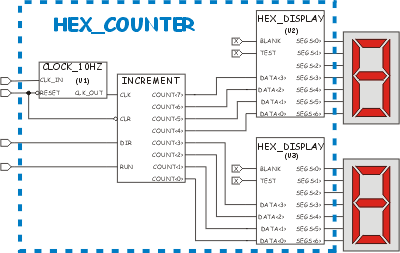Solution to the HEX Counter Problem
| This is the solution I came up
with for the HEX Counter problem. The drawing on the right is the
"logical" schematic of the result.
The specification called for an 8 bit counter that displayed its count on two hexadecimal displays. The input is again 24Mhz and the counter operates at 10Hz. Things I learned from this project:
|
 |
| In the schematic above, the
various logical parts are labeled as they are in the VHDL code. The
CLOCK_10HZ part is "U1", the HEX_DISPLAY parts are
"U2" and "U3." The process block that defines the
counter is labeled "INCREMENT."
Note that the BLANK and TEST inputs are not connected. In the VHDL code I had to use a bogus signal declaration in order to achieve that effect. With the WebPACK compiler (XST VHDL) you can just put the constant '0' or '1' in the port map and it does the right thing with them. |
VHDL Source Code for the Hex Counter
-- Project 4 Chuck McManis
--
-- This is a two digit hex counter with direction control
-- and start/stop control.
--
library IEEE;
use IEEE.STD_LOGIC_1164.ALL;
use IEEE.STD_LOGIC_ARITH.ALL;
use IEEE.STD_LOGIC_UNSIGNED.ALL;
entity hex_counter is
Port ( src_clk : in std_logic;
dir : in std_logic;
run : in std_logic;
clr : in std_logic;
display0 : out std_logic_vector(6 downto 0);
display1 : out std_logic_vector(6 downto 0));
end hex_counter;
-- This version was synthesized with the Synopsys VHDL compiler. It was failing
-- in a mysterious way when I had the run pin controlling the clock sensitivity
-- loop. I had expected that it would simply put the clock through an AND gate
-- before driving the counter but that was not what happened.
architecture behavioral of hex_counter is
component hex_display port (
test, blank : in std_logic;
data : in std_logic_vector(3 downto 0);
segs : out std_logic_vector(6 downto 0));
end component;
component clock_10hz port (
clk_in, reset : in std_logic;
clk_out : out std_logic);
end component;
signal clk : std_logic;
signal count : std_logic_vector(7 downto 0);
-- bogus
signal xx : std_logic;
begin
xx <= '0'; -- this is a "false" constant...
-- create instances of the clock divider and displays, and then attach
-- them to the signals we are using.
u1: clock_10hz port map (clk_in => src_clk, clk_out => clk, reset => clr);
u2: hex_display port map (test => xx, blank => xx,
data => count(7 downto 4), segs => display0);
u3: hex_display port map (test => xx, blank => xx,
data => count(3 downto 0), segs => display1);
increment: process (clk, clr, run, dir) is
begin
if (clr = '0') then
count <= "00000000";
elsif rising_edge(clk) then
if (run = '1') then
if (dir = '1') then
count <= count + "00000001";
else
count <= count - "00000001";
end if;
end if;
end if;
end process;
-- This version of the if loop fails to synthesize. Why? The XST compiler
-- generates logic for it.
--
-- elsif (rising_edge(clk) and (run = '1')) then
-- if (dir = '1') then
-- count <= count + "00000001";
-- else
-- count <= count - "00000001";
-- end if;
-- end if;
end behavioral;